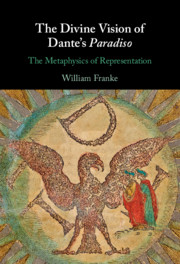Book contents
- The Divine Vision of Dante’s Paradiso
- The Divine Vision of Dante’s Paradiso
- Copyright page
- Contents
- Figures
- Prologue
- Acknowledgments
- Note on Translations and Primary Source Editions
- Part I The Literary Vision
- Chapter 1 Writing as Theophany: The Medium as Metaphor for Immediacy
- Chapter 2 The Presence of Speech in Writing: Speaking as Sparking
- Chapter 3 The Parts of Speech: Mediation and Contingency
- Chapter 4 From Speculative Grammar to Visual Spectacle and Beyond
- Chapter 5 Sense Made Sensuous and Synaesthesia in the Sight and Sound of Writing
- Chapter 6 Infinite Script: Endless Mediation as Metaphor for Divinity
- Part II Philosophical Reflections
- Appendix Paradiso XVIII. 70–136
- Index
Chapter 4 - From Speculative Grammar to Visual Spectacle and Beyond
from Part I - The Literary Vision
Published online by Cambridge University Press: 26 August 2021
- The Divine Vision of Dante’s Paradiso
- The Divine Vision of Dante’s Paradiso
- Copyright page
- Contents
- Figures
- Prologue
- Acknowledgments
- Note on Translations and Primary Source Editions
- Part I The Literary Vision
- Chapter 1 Writing as Theophany: The Medium as Metaphor for Immediacy
- Chapter 2 The Presence of Speech in Writing: Speaking as Sparking
- Chapter 3 The Parts of Speech: Mediation and Contingency
- Chapter 4 From Speculative Grammar to Visual Spectacle and Beyond
- Chapter 5 Sense Made Sensuous and Synaesthesia in the Sight and Sound of Writing
- Chapter 6 Infinite Script: Endless Mediation as Metaphor for Divinity
- Part II Philosophical Reflections
- Appendix Paradiso XVIII. 70–136
- Index
Summary
The profoundly theoretical approach to language on the part of the modistae resulted in the “speculative grammar” that is reflected in Dante’s representation of a deep structure of language. At this level, language is “one in all” (“una in tutti”), yet this underlying condition of unity is not as such articulable. Dante envisages ultimately a unity beyond language altogether. Dante cannot represent God as such, but he can imitate God’s art by a total artifice that absorbs matter into its own creation of form. This hyper-artificiality of Dante’s writing makes images revelations not of anything that is as such but of an unlimited indeterminate power of creation that performs in the image of God. It works on a necessarily negative logic. God is “seen” negatively, or is understood (by Dante in heaven) through the invisible divinity’s being manifest analogically in an infinite process of mediation that then dissolves and so points back to its invisible source. This is allowed to occur by Dante’s making the linguistic, and specifically written, medium itself his object of contemplation – in effect, the visio Dei. God can be given to experience only through mediations, specifically through their infinity, and Dante’s vision of divinity in the mediations of language says as much. In some sense, Dante suggests, his vision of the medium (writing) gives rise to an immediate vision of the divine. This paradox is explored and illuminated through the phenomenology of Merleau-Ponty and through art theory and the anthropology of images. Contemporary art historians and theorists have meditated deeply on the role of images in making absence present. Through emphasizing the writtenness of his vision of God in Paradise, Dante is already bringing out into the open what particularly Didi-Huberman and Jean-Claude Schmitt, as well as Hans Belting, emphasize about images as making absence present. They glimpse the unlimitedness of this absence, moreover, sometimes even in its theological implications and connotations. This realization of absence can become a kind of enactment of divinity, an incarnation in mental experience, and even in an aesthetic medium, of God. Metaphysical reality is thus made to appear through the image. A theologization of the presencing of absence through the image can surely be discerned in Dante’s “scenography” in the Heaven of Jove.
Keywords
- Type
- Chapter
- Information
- The Divine Vision of Dante's ParadisoThe Metaphysics of Representation, pp. 108 - 137Publisher: Cambridge University PressPrint publication year: 2021

